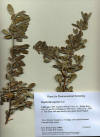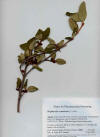|
Shepherdia argentea |
Shepherdia canadensis |
|
Washington. Wenatchee NF: Icicle Creek, along south side of River on trail between Chatter Creek and Jack Creek; 47º19.436, 120º34.626", 2825 ft. Dense riparian forest on nearly level rocky soil with Abies grandis, Thuja plicata, Picea englemannii, Tsuga heterophylla, Pinus monticola, P. ponderosa, Pseudotsuga menziesii, Larix occidentalis, and understory shrubs Acer circinatum, Amelanchier alnifolia, Alnus sinuata, Arctostaphylos uva-ursi, Berberis nervosa, Cornus sericea, Lonicera involucrata, Menziesia ferruginea, Paxistima myrsinites, Rubus parviflorus, Shepherdia canadensis, Rosa woodsii and herbs Smilacina racemosa, Xerophyllum tenax. 12 July 2010.
|
Shepherdia rotundifolia Utah—Great Basin Desert. Garfield Co., Dixie NF: Along Hwy 12 between Henrieville and Escalante Petrified State Forest; 37º37'32.1", 111º51.04.4", 2178 m. Pinyon-juniper woodland on loose granular soil derived from limestone and shale. Richard Spjut & Susan Spjut 16297, May 2008
|
|
Trees and Shrubs of Kern County (Jan 2013)
Shepherdia argentea (Elaeagnus argentea Pursh 1813) Nuttall 1818. Silver buffaloberry. Deciduous shrub or small tree to 6 m with many short thorny branches; stems silvery; leaves opposite, blade-like, 3–5× longer than wide, 2.5–6 cm, generally wider above the mid region, tapered more to petiole 4–12 mm, than to the rounded apex, entire, densely silvery scurfy; flowering Apr–May, before leaves appear; flowers clustered, with a 4-parted calyx, no petals; fruit an acrosarcum—an an undifferentiated pericarpium enclosed by a fleshy calyx, ripening red in this species. Widely distributed in the western U.S. with an aberrant distribution in California (Modoc, Mono, Alpine, Inyo, Kern, Ventura, Santa Barbara Cos.). Type from the banks of the Missouri. Kern Co.: “A small colony of very old plants grow in the damp soil in full sun at Mil Potreros in the San Emigdio Range” (Twisselmann). Three records in CCH—from Mt. Pinos, head of San Emigdio Creek, 1,341–1,676 m. Fruit eaten by the Blackfoot, Cheyenne, Dakota and Navajo for stomach aches, fevers, and as a laxative (Moerman); the name buffalo berry given by the travelers in the 1800’s for mixing the “berries” with buffalo meat to make them more edible. An aqueous ethanol extract of a seed sample collected from North Dakota in Nov 1966 was active in a solid tumor (WA) in the NCI screen (CPAM 1977). Reported to contain Tetrahydroharmol, which may be hallucinogenic. Shepherdia rotundifolia, which occurs outside California, will easily cause skin irritation (pers. contact, in collecting samples for antitumor screening). |
|





